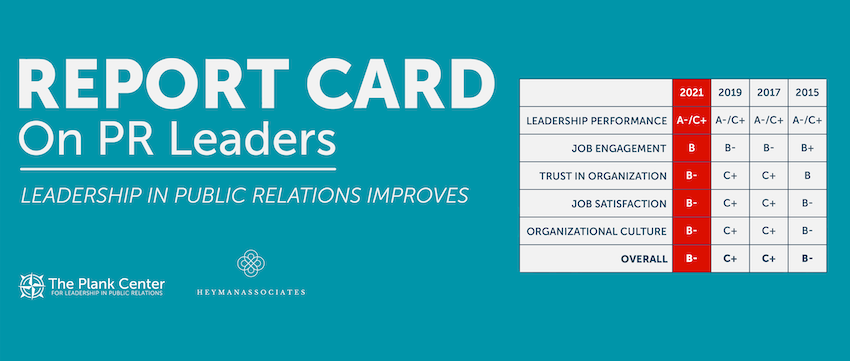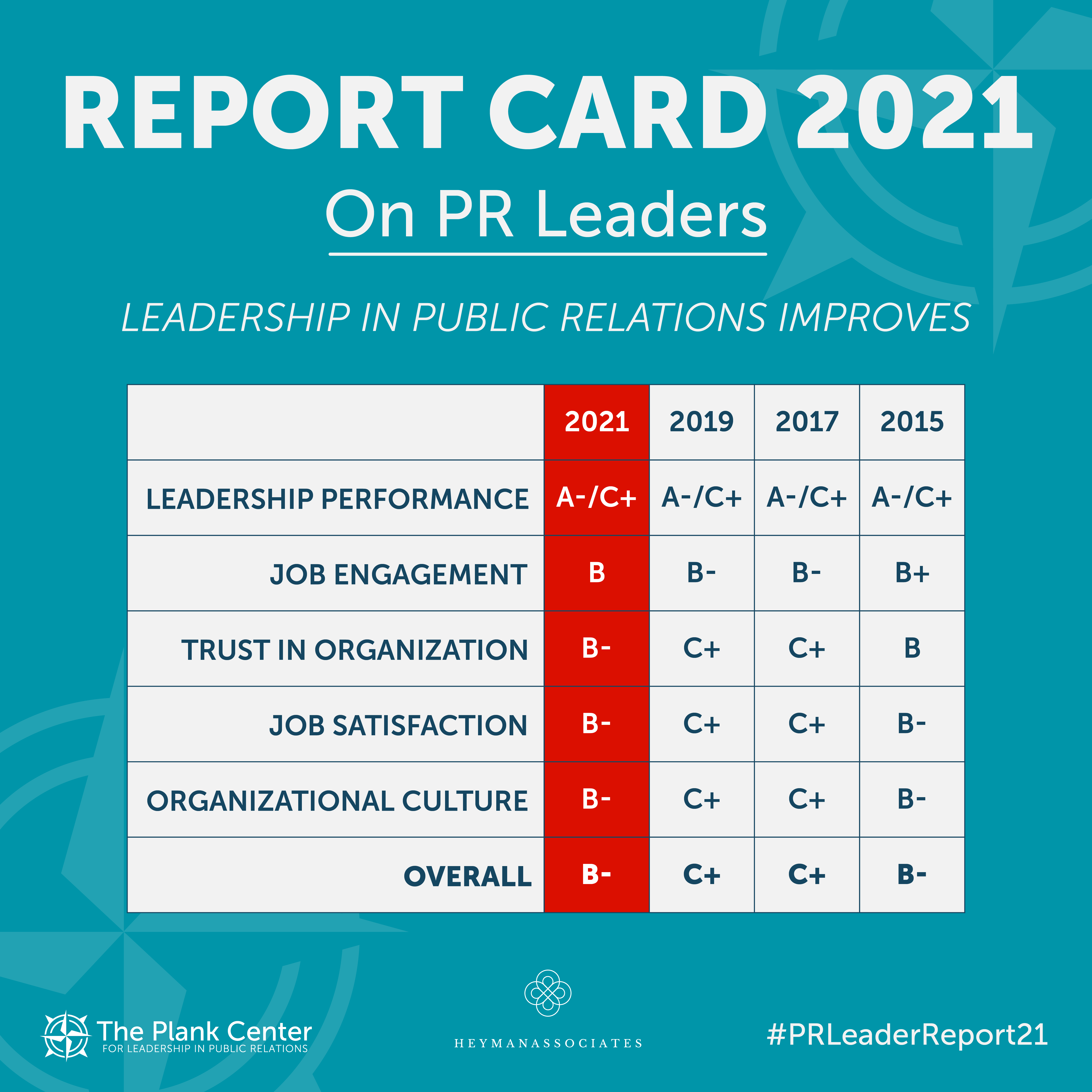PR leaders raise grade to B- in the Plank Center’s Report Card 2021

PR leaders raise grade to B- in the Plank Center’s Report Card 2021
Did the pandemic and social turmoil drive improved performance?
Leaders in public relations improved their performance during the volatile and challenging world of 2020-2022. For the first time since the Plank Center for Leadership in Public Relations launched its biennial Leadership Report Card in 2015, the grade for overall leadership performance rose to B-.
“It is promising to document the improved leadership during and after times of uncertainty and radical changes,” said Juan Meng, Ph.D., co-investigator, board member at the Plank Center for Leadership in Public Relations and associate professor at Grady College. “It is even better to observe the closed gap between men and women when evaluating their leaders. As the society is moving rapidly to embrace DE&I, leaders should rethink what kinds of effective practices their organizations need to ensure sustainable improvements in leadership.”
The 2020-2022 survey period was a volatile time marked by: 1) the pandemic; 2) George Floyd’s murder by police in 2020, which sparked protests and marches calling for greater social justice and DE&I; and 3) a bitter presidential election pounded by waves of mis- and dis-information in social and national media that further divided the nation.
Against this background, public relations leaders were resilient and improved their leadership. Did the pandemic, or a greater focus on DE&I, or concerns about truth and accuracy drive these improvements? To some extent certainly, but the survey was not designed to measure this. The 2023 Report Card should reveal whether the leadership gains in 2021 were lasting or not.
The Grades
Leadership Performance: A-/C+ (2019—A-/C+)
This is a split grade because leaders’ and their employees’ perceptions of performance continue to differ sharply. Top leaders (232 or 43.3%) rated their performance (6.17 /7.0 scale) about an “A-,” while other employees (304 or 56.7%) rated their top leaders’ performance (4.75/7.0) a “C+.” Scores for top leadership performance were slightly higher than in 2019 (6.09 vs. 4.49), but the size of the gap in all four Report Cards is virtually the same. For the first time, no significant differences were found between women and men on their evaluations of leadership performance.
Job Engagement: B (2019—B-)
Job engagement, based on Gallup’s engagement survey, reached its highest level versus previous studies. In addition, for the first time, no significant differences were found regarding engagement between women and men. Based on responses to the questions, respondents are grouped into three categories: engaged, not engaged, and actively disengaged.
In this Report Card, 61.2% of respondents were engaged (highest level in the four studies); 31.9% were not engaged; and 6.9% were actively disengaged (down from 8.0% in 2019).
Organizational Culture: B- (2019—C+)
Culture refers to the internal environment, processes and structures facilitating or impeding communication practices. Cultural improvements appeared across all items in this Report Card; surveyed participants graded it a “B-,” the highest (mean) score in four reports.
Rated highest again was the CEO’s or top leader’s understanding and valuing of public relations (5.69 up from 5.48 in 2019). The understanding and valuing of PR by other functional leaders, however, was rated significantly lower (5.02 versus 4.95 in 2019). Men rated culture more positively (5.23 vs. 5.07 in 2019) than women (5.04 vs. 4.83 in 2019), notably on elements like two-way communication, shared decision-making, and diversity. Among organizational types, agency professionals rated cultural factors highest (5.76).
Trust in the Organization: B- (2019—C+)
The overall grade for trust in the organization (5.08/7.0 scale) was a “B-,” the highest level of trust in the Report Cards to date. Trust scores once again were consistently lower at each level in the chain of command. Top leaders rated trust (5.46) significantly higher than other levels (4.71).
Women (4.96) continued to be less trusting of their organizations than male professionals (5.19), though the gap in the 2021 survey was not as pronounced as in previous surveys. The improvement in trust, after small declines in scores in the three previous studies, is noteworthy.
Job Satisfaction: B- (2019—C+)
Job satisfaction improved versus small declines in the two previous surveys, and the overall grade rose from a “C+” to a “B-.” In terms of percentages, the numbers rose slightly from 2019 when the percentage of PR leaders and professionals who were satisfied with their job was 62.1% versus 63.6% in this 2021 Report Card. Job satisfaction is highest among top leaders (72.8 %). Men (66.8%) were more satisfied with their job, if compared to women (60.5%).
Summary
Grades for all five areas for leaders improved, especially in job engagement and job satisfaction. Mean scores in most areas rose modestly. Thus, the overall leadership grade rose from a C+ to a B-, the first improvement since 2015. In addition, one of three crucial gaps revealed in previous studies—the gender gap—was closed in this Report Card.
The two other big gaps remain between: 1) perceptions of top communication leaders versus their employees, and 2) existing culture and a much richer culture for communication. The gaps must be reduced to strengthen leadership, practice and outcomes. The gaps may be reduced through 1) increased power sharing, or leader-empowering behaviors, 2) better two-way communication, and 3) richer interpersonal skills in conflict management, active listening and empathy, among others.
“The purpose of this biennial report is to assess PR leadership and identify enrichment opportunities for it,” said Bruce K. Berger, Ph.D., co-investigator and professor emeritus, University of Alabama. “If we identify the gaps and work to close them, we strengthen our profession’s leadership—a crucial strategic asset. This Report Card identified some improvements over the past two difficult pandemic years, but some crucial gaps and issues remain, as does the urgency to act.”
Project Background and Demographics
The Report Card 2021 was based on responses from 536 PR leaders and professionals in the United States. A 42-question survey was distributed online to more than 22,000 public relations leaders and professionals contained within an extensive database, and 568 completed the survey; 32 surveys completed by non-US-based participants were excluded, leaving 536 surveys for data analysis. This response provides a 95% confidence level (+/- 5%) the results represent the larger population of surveyed professionals. Most participants were experienced, high-level leaders and managers. More than three-quarters (83.2%) of the 536 respondents were the #1 (43.3%) or #2 (39.9%) communication professional in their organization. More men (286 or 53.6%) than women (248 or 46.4%) completed the survey. The majority of participants worked in public (157 or 29.3%) or private/state-owned (102 or 19.0%) firms. Most participants (455 or 84.9%) were Caucasian. The percentage of non-Caucasians (e.g., Black/African American, Latino/Hispanic, Asian or Asian American, multi-racial, etc.) is 15.1%, higher than in previous surveys.
To download and read the Report Card 2021 full report, please visit the Plank Center’s website
